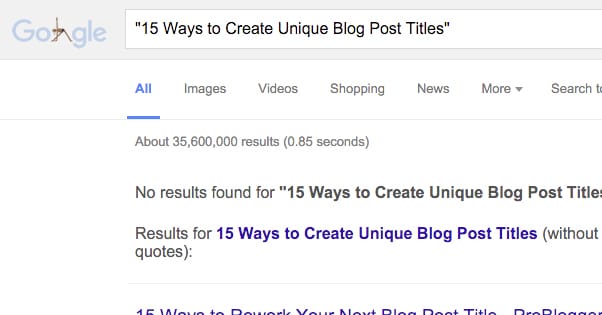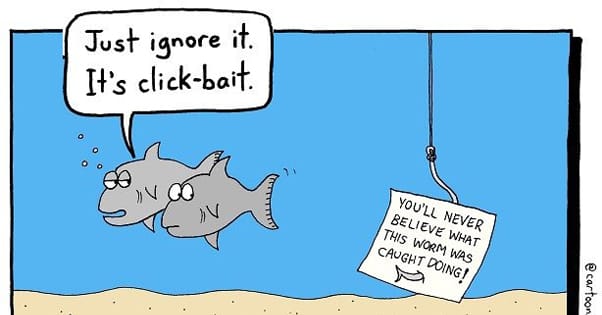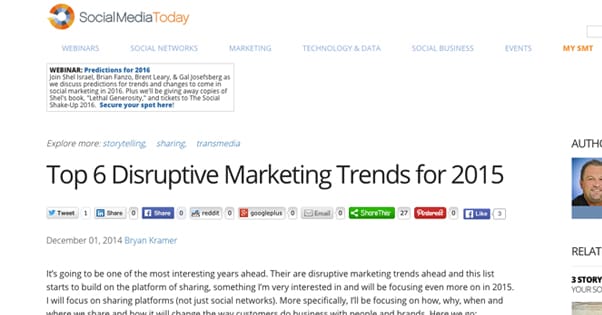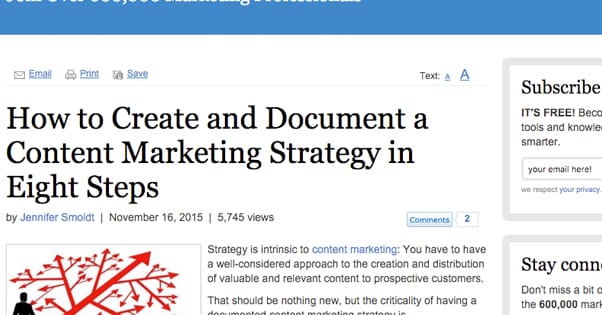15 Tips Copywriters Use to Create Perfect Blog Headlines
Published by Kenny Novak • Content Marketing • Posted December 14, 2015 ContentPowered.com
ContentPowered.com
Your blog headline is possibly the most important part of a blog post. The reason is that everyone reads headlines, but very few people click through to keep reading the post. From a Google search page, you get a headline and a quick blurb to help you attract readers, and many users ignore the description because it’s so rarely useful. Social media shares often have even less, possibly even a truncated version of the title on Twitter.
With that in mind, you really, really need to put a lot of thought into your post titles. They need to be attractive, short, relevant, and interesting, among other things. It’s a lot of work. Upworthy even shared an inside look, about how they create 25 headlines for every piece of content they post, looking for that perfect title.
I’m going to be honest here. It’s hard to ask professional bloggers how they come up with titles, because many of them don’t have a process. They have an internalized feel for what a good title should be, but putting that feeling down into words or a process you can follow is quite a bit more difficult. It doesn’t help new bloggers or people having trouble with title creation.
That’s why I put this list together. It’s reverse-engineered, it’s compiled, and it’s ready to go to help you make better titles. Skip those terrible title generators, or just use them for topic ideas and make up titles of your own. Formulas don’t work; it takes learning and experience. Write titles until you can write no more, and eventually you’ll be writing great titles.
1. Use Numbers
There’s a reason you see numbered lists constantly, everywhere, on every platform and for every topic. They promise a fixed number of items of value. If I tell you I’m going to give you the top 10 pieces of analytics software, you’re expecting 10 pieces of software. You know what you’re getting, and I know what I’m providing you. Sure, some will be obvious – one entry is almost always going to be Google Analytics – but that’s fine. A little information attrition never hurt anyone.
There have been studies performed in the past about the “best” number to shoot for with your lists, but I find that it’s really much more variable than such studies imply. For example, this post studied Buzzfeed and determined that the number that received the most traffic was 25.
Now, my flaw with this survey is that it just studies Buzzfeed, which produces a lot of very similar content. For business blogging, things work a little differently. A post for a business blog should aim for 2,000-3,000 words. A top 25 list then will average around 100 words per entry, which isn’t much room for detail. A shorter list gives you more room for value about each point, while a longer list gives you the chance to recommend a larger volume. Pick the direction you would like to go, and don’t let Buzzfeed guide your marketing.
2. Use Specific Terms
Don’t say the “top 10 ways to improve your business.” Say something more like the “top 10 ways to increase landing page conversions.” Specificity is important, because the more generalized a title is, the fewer people will care to keep reading to find out what’s up. Even clickbait tends to be specific.
The key here is that ever-elusive concept of value. You want to provide value to your readers, and your readers want to know going in what kind of value they’ll be getting. You can’t just saying you’re going to “make improvements,” you need to say precisely what those improvements are.
Plus, using more specific terms means you’re more likely to be able to work an important keyword into the title, so you have that going for you too. A little bonus SEO value can go a long way.
3. Use Superlatives
You don’t have 10 tips, you have the Top 10. You don’t have good advice, you have the Best Advice. You’re not sharing inside information, you’re Revealing Crucial Secrets to Success. You’re not giving away great strategies, you’re sharing First-Rate Solutions.
Superlatives are language taken to the extreme. It’s taking normal, run of the mill adverbs and adjectives and cranking them up to 11. Your content is not great, not greater, but greatest.
Superlative language is very attractive, because it’s not the kind of phrasing people use lightly. Except when it is, of course, but that’s not how we’re wired to understand it as part of our language. Rather, when we’re told to expect the best, we’ll look for the best. When we’re told to expect something merely good, we don’t think it will be great but humble; we think it will be lackluster all around.
4. Make it Unique
There’s nothing inherently wrong with writing a post with the same title as another post published by someone else, so long as that title is ultra-generic. There are several ultimate guides to PPC or SEO out there, and that hasn’t stopped other people from writing them.
However, many of the other tips on this list help you make a unique title. If you then find that the title you created is not unique after all, change it! There’s no good reason to copy a title when someone else has written it. It just lends the impression that you took their title and are taking their content too, even if your content is completely different.
On the flip side, don’t worry too much about the uniqueness of your title until you’re about ready to publish. Come up with your list of possible titles, then run searches to see if the ones you like most are taken. They might, or they might not; adapt as necessary.
5. Avoid Overt Clickbait
Clickbait titles tease but give you no information. Worse, they follow up with a pithy question, a “#9 is unbelievable” or something similar. This is annoyingly effective in the short term, for viral content, but it’s not great for a big brand or an evergreen article.
The way clickbait works is because of the curiosity gap. The curiosity gap is the concept of a title not providing you the information you want, but opening the framework for that information.
Upworthy pioneered that method of headline, but they’ve even stopped doing it. It was a novel technique for a while, but it has ceased to be all that valuable, and you know a strategy is dying when even the creator is abandoning it.
6. Show the Benefits
One example I read about was a blogger who titled a post “You Will Be Missed.” So, what’s the context of that post? Is it about a friend dying? It is about a pet dying? Is it about a beloved computer breaking? As it turned out, it was about the death of Steve Jobs.
This displays numerous title flaws, but the biggest one is simply that you have no idea going into it what you’ll be getting out of it. A good blog title has a benefit baked in. “10 All-Star Methods to Boost ROI by 200%” is a great title. It has a number, it has a superlative, and it has what you’re getting out of it; a 200% boost in return on investment.
Now, you don’t always need to make specific promises for a percentage boost, or what have you. Sometimes a more generic option works better. Ideally, when you give a specific number like that, you have statistics to back it up. I see this a lot in context where the blogger in question implemented those ten techniques and got a 200% boost, and is now writing to share that experience.
7. Ask a Question
Questions are great for blog titles because they inherently involve the reader, before the reader has even begun to read. Ideally, you ask them a question about the topic of your post. For example:
- Are You Missing Out on an Extra Thousand Visitors?
- Did You Miss This Common Growth Opportunity?
- What Would You Do For a Klondike Bar?
When you ask a question in your post title, you need to go on to answer it, or provide a means for the reader to answer it themselves, assuming it’s that sort of question. So, you know, don’t ask readers if they want an extra 1,000 visitors if you don’t have tips to help them find that many visitors.
8. Use a Negative Perspective
Negativity is often combined with a question, as in the “miss this opportunity” example above. There are essentially three ways to use negativity in a title in a way that doesn’t drive people away.
The first way is to use it in a question. “Are You Doing X Bad Thing?” That’s negativity phrased in a way that helps you help the reader avoid doing that bad thing.
The second way is to take a glib approach. Provide anti-tip, “tips” to doing something poorly. It’s really a thinly veiled way to provide positive tips, by reversing them and saying what not to do.
The third way is to take a negative happening in your industry and examine it. A loss of customers, a failed product launch, anything of the sort can still be analyzed for detail to see if there were ways the business involved might have been able to get ahead instead of falling behind.
9. Use Interesting Words
This is very much like using superlatives, only you’re picking words that aren’t necessarily adverbs or adjectives, and that are not really commonly used. Maybe you want to talk about the “shocking” secrets of content marketers, or the “disruptive” techniques black hat marketers use.
The caveat here is to avoid using obscure words here. If you don’t think the common reader would know what the word means, you don’t want to put forth a bad impression by using it. You don’t want to tell someone about the benefits of mastication if no one knows what the word means; you either have to define it and waste space in doing so, or you have to let users misinterpret it or live in the dark. Neither one is a very good option.
10. Keep it Short
How long should a blog title be? One of the commonly-cited figures is 70 characters or less. This works, and it gives you room to tweet a blog title without running into limits, but search engines cut off closer to 65. On the other hand, some extremely valuable content out there has significantly longer titles, and a long, descriptive title can go a long way towards making a piece of content go viral.
In general, I recommend keeping your titles relatively short, but not being shy about longer titles if they meet other criteria. A title that’s too long can still be highly interesting and relevant. Just make sure you’re not shooting yourself in the foot by pruning out value from the title.
11. Avoid Most Abbreviations
Remember, often times you’re writing towards a generalist audience, not a specialist audience. The people reading your posts might be interested in your industry, but that doesn’t mean they’re experts. Even if an abbreviation is really common, doesn’t mean it’s perfect for all readers. Acronyms and abbreviations are only allowable when audience awareness is available.
Something like B2B might be a fine abbreviation in a business blog, but in a less niche blog wouldn’t work. Something like ROI works in any blog pointed at businesspeople at all, but might fly over the head of an absolute novice.
Think of it this way; it costs you nothing to use the full term once or twice before abbreviating it. Teach the term, then abbreviate it, and build that knowledge for the future.
Alternatively; if a reader has to access a glossary to figure out your title, they aren’t going to be reading your post.
12. Do a How To
One thing I didn’t mention in the “ask a question” section is the idea of asking a question and then answering it in the form of a guide. That’s because I don’t think that guides in the form of a question are the best way of formatting them. A lot of people will go looking for the answer of how can they perform X task, but they aren’t typing “How can I perform X task?” in Google. People have learned search engine pidgin, and will type in it. They would say “How to X”
What you’re doing here is essentially being a little more precise with the targeting of these people. With a how to title, you’re showing up more often and more valuably for the people who need your advice.
13. Reference the Target Audience
You’re running a business, right? That means you very likely have some audience personas in mind. You know who you’re advertising to, who you’re trying to reach. Write specifically to these people.
No, I don’t mean specifically writing to Jane from Wisconsin. Jane isn’t likely to stumble across your post, and if she did, she’d probably be a little freaked out about how you knew as much about her as you do. I’m talking about more general audience referencing, like how I mention that this is directed at business owners.
“Tips for New Niche Entrepreneurs.” “How to Build Your Comics Emprie.” Etc, etc.
14. Make it Match Your Content
Relevance is extremely important. If you tell me you’re going to give me 15 tips for a subject, I darn well better see at least 15 tips. You can spill over with bonus tips, that’s fine, but never go under the minimum. That’s just a minor issue, though. More dangerous is when you promise to talk about one subject but ramble on about another.
The problem here is two-fold. First, Google will see the mismatch between title topic and copy topic, and may consider it a bait and switch. This can earn you a penalty, though it’s generally far worse when ads and landing pages don’t match.
Second, it’s an indication that you started out working on one topic, ended up actually writing about another, and forgot to change your title. It’s a lacking of attention to detail, and it shows carelessness you can’t afford.
15. Don’t Settle For the First
The first title you come up with won’t be perfect, and that’s okay. Create a concept or a working title, and then write. Only once your done should you go back to change the title. Brainstorm numerous ideas – Upworthy suggests 25 – and prune them down to the best one. By doing so, you should be able to train yourself to come up with great titles off the bat.












